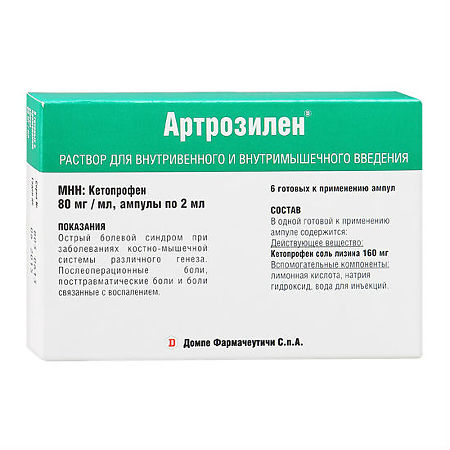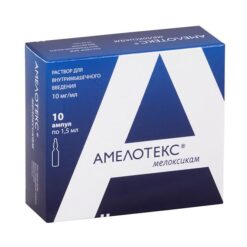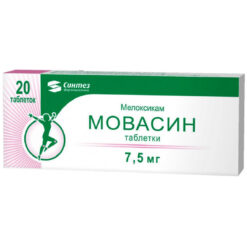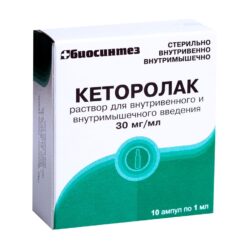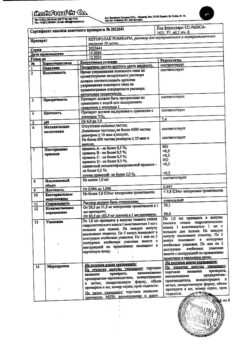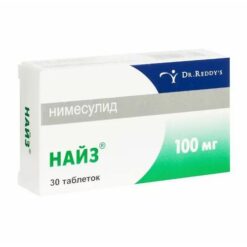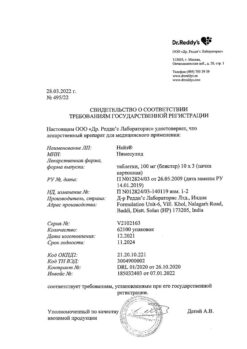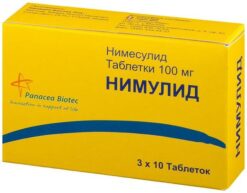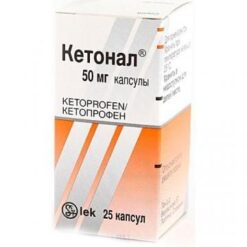No products in the cart.
Arthrosilen, 80 mg/ml 2 ml 6 pcs
€1.00
Out of stock
(E-mail when Stock is available)
Description
Pharmgroup:
NSAIDs.
Pharmic action:
Artrosylene is an NSAID.
It has anti-inflammatory, analgesic and antipyretic effects. By inhibiting cyclooxygenase types I and II, inhibits the synthesis of prostaglandins. It has anti-bradykinin activity, stabilizes lysosomal membranes and inhibits release of the enzymes from them, which contribute to destruction of tissues during chronic inflammation. It decreases release of cytokines. inhibits activity of neutrophils.
Limits morning stiffness and swelling of the joints and increases range of motion.
Ketoprofen lysine salt, unlike ketoprofen, is a rapidly soluble molecule with a neutral pH and is almost non-irritating to the gastrointestinal tract.
Ketoprofen lysine salt, unlike ketoprofen, is a rapidly soluble molecule with a neutral pH and is almost non-irritating to the gastrointestinal tract.
Pharmacokinetics:
The time to reach Cmax with parenteral administration is 20-30 min. The effective concentration is maintained for 24 h. Therapeutic concentration in synovial fluid is retained for 18-20 hours.
Up to 99% of absorbed ketoprofen is bound with plasma proteins, mainly with albumin. Vd – 0.1-0.2 l/kg. It easily passes through histohematic barriers and is distributed in tissues and organs.
Ketoprofen penetrates well into the synovial fluid and connective tissues. Although concentrations of ketoprofen in synovial fluid are slightly lower than in plasma, they are more stable (persists up to 30 h). It is metabolized by microsomal liver enzymes. It is excreted by the kidneys, 60-80% – as glucuronide during 24 hours.
Indications
Indications
For the short-term treatment of acute pain syndrome:
– diseases of the musculoskeletal system of different genesis;
– postoperative pain;
– post-traumatic pain and pain associated with inflammation.
Active ingredient
Active ingredient
Composition
Composition
1 ml:
– ketoprofen lysine salt 80 mg
Supplementary substances:
sodium hydroxide,
citric acid,
water d/i.
How to take, the dosage
How to take, the dosage
1 ampoule of Artrosilen per day in m/v or intravenously. The maximum dose is 1 ampoule 2 times a day.
Intravenous administration of the drug is allowed only in hospital. The drug is used for short-term treatment of up to 3 days. If further use of the drug is necessary, it is recommended to switch to oral dosage forms or suppositories. In elderly patients use no more than 1 ampoule per day.
Ampoules should be opened along the special break line. After opening the ampoule the solution shall be used immediately.
Aqueous solutions of ketoprofen lysine salt can be used in physiotherapeutic treatment (ionophoresis, mesotherapy): in ionophoresis the solution is applied to the negative pole.
In case of intravenous administration a slow infusion is recommended to increase the time of action of the drug. Solution for Artrozilen infusion is prepared on the basis of 50 or 500 ml of the following aqueous solutions: 0.9% sodium chloride solution, 10% aqueous levuleza solution, 5% aqueous dextrose solution, Ringer acetate solution, Ringer lactate solution (Hartman), colloidal dextran solution in 0.9% sodium chloride solution or 5% glucose solution. If Artrosilen is diluted in solutions of small volume (50 ml) – the drug is administered by IV bolus.
In large volume solutions (500 ml) – the duration of infusion is at least 30 minutes.
Interaction
Interaction
Inducers of microsomal oxidation in the liver (phenytoin, ethanol, barbiturates, flumecinol, rifampicin, phenylbutazone, tricyclic antidepressants) increase the production of hydroxylated active metabolites.
Decreases the effectiveness of uricosuric drugs, increases the effects of anticoagulants, antiaggregants, fibrinolytics, ethanol, the side effects of mineralcorticosteroids, glucocorticosteroids, estrogens. Reduces the effectiveness of hypotensive and diuretics.
Combination with other NSAIDs, glucocorticosteroids, ethanol, corticotropin may lead to ulcer formation and development of gastrointestinal bleeding, to an increased risk of renal dysfunction.
The simultaneous use with oral anticoagulants, heparin, thrombolytics, antiaggregants, cefaporazone, cefamandole and cefotetan increases the risk of bleeding.
Induces hypoglycemic effect of insulin and oral hypoglycemic drugs (requires recalculation of the dose).
Co-administration with sodium valproate causes impairment of platelet aggregation. Increases the plasma concentration of verapamil and nifedipine, lithium preparations, methotrexate.
Special Instructions
Special Instructions
The peripheral blood count and the functional state of the liver and kidneys should be monitored during treatment.
If 17-ketosteroid determination is necessary, the drug should be discontinued 48 hours before the study.
The administration of ketoprofen may mask the signs of infectious disease.
In case of impaired renal and hepatic function, dose reduction and close monitoring are necessary.
The use of ketoprofen in patients with bronchial asthma may lead to an attack of bronchial asthma.
Women who are planning to become pregnant should refrain from using the drug because it may reduce the chance of oocyte implantation.
Impact on driving and operating machinery
When using the drug, refrain from potentially hazardous activities requiring concentration and quick psychomotor reactions.
Contraindications
Contraindications
Hypersensitivity (including to other NSAIDs), “aspirin” asthma, gastric and duodenal ulcer (exacerbation), ulcerative colitis (exacerbation), Crohn’s disease, diverticulitis, peptic ulcer, hemophilia and other blood clotting disorders, chronic renal failure, children under 18 years), pregnancy, lactation.
With caution: anemia, bronchial asthma, alcoholism, tobacco smoking, alcoholic cirrhosis, hyperbilirubinemia, liver failure, diabetes, dehydration, sepsis, chronic heart failure, edemas, arterial hypertension, blood diseases (including leukopenia), glucose-6-phosphate dehydrogenase deficiency, stomatitis, old age.
Side effects
Side effects
Gastrointestinal tract: abdominal pain, diarrhea, duodenitis, gastrointestinal erosive ulcers, gastritis, hematomeisis, esophagitis, stomatitis, melena.
Liver: increased bilirubin, increased “liver” enzymes, hepatitis, liver failure, increased liver size.
Nervous system: dizziness, hyperkinesia, tremor, vertigo, mood swings, anxiety, hallucinations, irritability, general malaise.
Skin: urticaria, angioneurotic edema, pruritic exanthema, pruritus, maculopapular exanthema, increased sweating, erythema multiforme (including erythema exudative).
Genitourinary system: painful urination, cystitis, edema, hematuria, menstrual disorders.
Blood organs: leukocytopenia, leukocytosis, lymphangitis, decreased prothrombin time, purpura, thrombocytopenia, thrombocytopenic purpura, increased spleen size, vasculitis.
Respiratory system: bronchospasm, dyspnea, laryngospasm, laryngeal edema, rhinitis.
Cardiovascular system: hypertension, hypotension, tachycardia, chest pain, syncope, peripheral edema, pallor.
Allergic reactions: anaphylactoid reactions, oral mucous membrane edema, pharyngeal edema, periorbital edema.
Overdose
Overdose
To date, no cases of overdose with the drug Arthrosilen have been reported. In case of overdose it is necessary to monitor respiratory and cardiac activity. There is no specific antidote. If necessary, symptomatic therapy should be carried out. Hemodialysis is ineffective.
Pregnancy use
Pregnancy use
Like other NSAIDs, Arthrosilen should not be used in the third trimester of pregnancy.
The use of the drug in the first and second trimester should be closely monitored by the attending physician.
Breast-feeding should be discontinued when using the drug.
Similarities
Similarities
Additional information
| Shelf life | 2 years |
|---|---|
| Conditions of storage | In a light-protected place, at a temperature not exceeding 25 °C |
| Manufacturer | Dompe Pharmaceutici S.p.A., Italy |
| Medication form | solution |
| Brand | Dompe Pharmaceutici S.p.A. |
Related products
Buy Arthrosilen, 80 mg/ml 2 ml 6 pcs with delivery to USA, UK, Europe and over 120 other countries.

